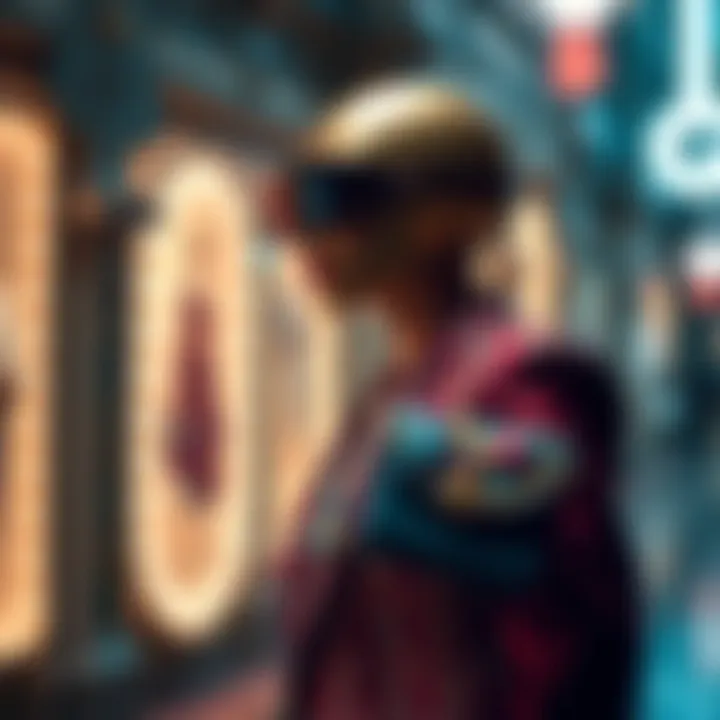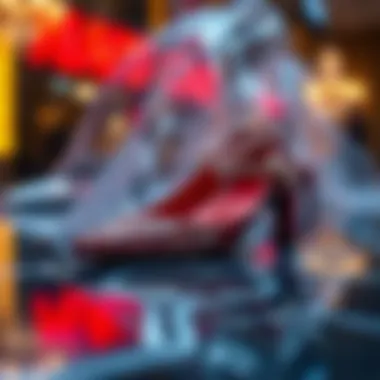Dolce and Gabbana's Bold Step into the NFT Landscape


Intro
In the fast-evolving domain of fashion, the lines between physical and digital have begun to blur, particularly with the rise of non-fungible tokens (NFTs). Sicilia’s own Dolce and Gabbana have set a remarkable example by daringly diving into this world, marrying luxury fashion with cutting-edge technology. But what spurred this innovative leap? And what does this mean for the traditional fashion landscape and the consumer habits within it?
For investors and consumers alike, understanding the core concepts of cryptocurrency is vital. The underlying blockchain technology of NFTs is not just a trend; it’s a fundamental shift in how assets can be owned and traded. With a plethora of luxury brands treading cautiously, Dolce and Gabbana have taken bold steps, hungry to explore the intersection of digital creativity and opulence. This article aims to dissect this venture, exploring the motivations behind it and its potential repercussions on the market and consumer behavior.
Understanding Cryptocurrency Concepts
As we dive into this topic, grasping the essence of cryptocurrency is critical. Many might be novices in this area, hence a solid grounding is necessary to fully appreciate Dolce and Gabbana’s audacious endeavor.
Blockchain Technology Explained
To understand NFTs, one must begin with blockchain technology. Essentially, a blockchain is a decentralized ledger that records transactions across multiple computers. This means that once a piece of data is added, it becomes nearly impossible to alter, establishing a high level of trust and transparency. Now, when it comes to NFTs, this technology ensures that each token is unique, attached to specific digital assets, which cannot be substituted for another.
The beauty of blockchain lies not only in its inherent security but also in its ability to empower creators and designers by granting them control over their work. This is a game-changer for fashion houses like Dolce and Gabbana, giving them a chance to reach younger, digitally-oriented consumers who value exclusivity and ownership.
Key Terms Every Investor Should Know
Navigating the world of NFTs can be daunting without a firm grasp on the key terminology. Here are some essential terms:
- NFT (Non-Fungible Token): A digital asset that represents ownership of a unique item or piece of content, secured on the blockchain.
- Minting: The process of creating an NFT and registering it on the blockchain.
- Gas Fees: These are transaction fees paid to miners for processing and validating transactions on the blockchain. They can fluctuate based on demand.
- Wallets: Tools that allow users to store, send, and receive cryptocurrencies and NFTs.
Understanding these terms lays the groundwork for comprehending the broader implications of Dolce and Gabbana’s foray into the NFT space.
"As digital art and collectibles gain traction among consumers, traditional boundaries in fashion are dissolving before our eyes."
Closure
As we move forward in this exploration, it’s crucial to keep an eye on how brands like Dolce and Gabbana navigate this intricate landscape. The implications for luxury fashion could be transformative, re-defining ownership, engagement, and even consumer loyalty in the digital age. We’ll also dive into the market analysis, identifying current trends and potential strategies for investors looking to ride this wave of change.
Preamble to NFTs in the Fashion Industry
The integration of non-fungible tokens (NFTs) into the fashion industry has ushered in a notable paradigm shift. High-end brands are rapidly adapting to emerging technologies, particularly as consumers become more digitally savvy. This section explores why NFTs are significant to fashion, examining how they change the traditional concepts of ownership and value in luxury goods.
Definition and Significance of NFTs
To understand the relevance of NFTs in this domain, one must first grasp what they truly are. Non-fungible tokens are unique digital assets verified using blockchain technology. Unlike regular cryptocurrencies which are interchangeable, NFTs stand alone, each representing distinct ownership of a digital or physical item. In fashion, this unique characteristic allows brands to sculpt new pathways for commerce and connection with their clientele.
The significance of NFTs is multifaceted:
- Perceived Value: By creating scarcity, NFTs elevate fashion items to coveted status. This variance in demand is reminiscent of limited-edition releases in traditional retail, where exclusivity drives consumer engagement.
- Digital Provenance: The ability to trace ownership from creator to consumer allows for novel narratives crafted around products. This transparency can build trust and enhance brand loyalty.
- Infrastructure for Community Building: NFTs provide a framework for brands to engage directly with consumers, creating interactive ecosystems where feedback and participation can flourish.
"NFTs are reshaping how we think about possession, especially in luxury markets where brand narrative and ownership history reign supreme."
Historical Context of Fashion and Technology Integration
Examining the marriage of fashion and technology isn't a modern concept. As far back as the late 20th century, designers were experimenting with digital tools to spark innovation and creativity. The early days of online shopping in the 90s heralded a shift in consumer behavior, emphasizing convenience and choice.
Fast forward to the twenty-first century, and the integration of technology has only intensified. Social media platforms like Instagram and Pinterest have not only informed trends but also dictated purchasing decisions. Now in the era of Web 3.0, the line between the digital and physical worlds is blurring further with NFTs, leading brands like Dolce and Gabbana to embrace this novel frontier more than others.
This evolution symbolizes a larger cultural shift—where digital ownership and cultural relevance intertwine—and it opens the door for a continued fusion between technological advancement and fashion. Through this lens, NFTs are not just a fad; they represent the future of luxury consumption, echoing the age-old battle of innovation versus tradition.
The leap into NFTs by fashion houses reflects a conscientious effort to remain relevant in a rapidly changing landscape, one that encourages connection and individuality amidst consumer needs. As the narrative of fashion takes a modern twist, understanding these foundational elements of NFTs will illuminate their transformational power in this industry.


Dolce and Gabbana's NFT Collection Launch
Dolce and Gabbana's entry into the NFT scene marks a significant milestone in the marriage of fashion and cutting-edge technology. As the brand blends its iconic luxury aesthetic with digital assets, it creates ripples not only in the realms of existing consumer culture but also in how fashion brands conceptualize value and ownership. This move is not just about selling art or memorabilia; it represents a transformative approach toward engaging audiences who are increasingly seeking unique experiences, blurring the lines between the physical and digital worlds.
Overview of the Collection
The NFT collection by Dolce and Gabbana is impressively multi-faceted, featuring a mix of wearable digital art and pieces that echo the brand’s deep-rooted heritage. Launched with much fanfare, the collection comprises around 9 unique digital pieces, each designed to captivate the imagination of collectors and fashion aficionados alike. Among the most notable items is the "Collezione Genesi,” which is not merely about ownership but rather about forging connections between creators and consumers in a new digital era.
Some pieces of the collection also include a range of animated looks, lending a dynamic aspect to the static nature of traditional fashion presentation. Available exclusively on the Ethereum blockchain, the collection stands as a testament to what the future holds for luxury goods in the digital age.
"Dolce and Gabbana is stepping into the future of fashion with a level of innovation that redefines ownership and creativity."
Artistic Vision Behind the NFTs
What drives Dolce and Gabbana's NFT initiative is a profound artistic vision that combines technology with haute couture. The brand approached this venture with a distinctive narrative, setting itself apart from a typical digital drop. Each NFT in the collection unfolds a story, often tied to the brand’s historical and cultural influences, infusing traditional craftsmanship with modern digital artistry.
The creative minds behind the designs effectively harnessed elements of Italian art and fashion, from intricate patterns to lavish textures, seamlessly translating them into the realm of digital art. The collection represents a marriage of divergent worlds—where the timeless elegance of fashion meets the innovative allure of digital technology.
Themes and Concepts Represented
Within this luxurious digital tapestry, several recurring themes emerge, shedding light on the evolving perceptions around fashion, art, and ownership.
- Heritage and Innovation: The collection juxtaposes Dolce and Gabbana's rich Italian heritage with the modernity of blockchain technology, highlighting a unique fusion of past and future.
- Exclusivity vs. Accessibility: While NFTs are typically seen as elite digital assets, the brand's approach raises questions about accessibility and how it can redefine luxury consumption.
- Sustainability in Digital Fashion: The move towards digital assets can be seen as a step toward reducing the environmental footprint of fashion, prompting a broader discussion on sustainability.
Technological Aspects of Dolce and Gabbana's NFTs
Delving into the technological aspects of Dolce and Gabbana's NFTs reveals a complex interplay of innovation and creativity. This facet not only enhances the brand's digital portfolio but also serves as a crucial bridge between traditional luxury and modern digital ownership. The key elements to consider in this context include the adoption of blockchain technology and the utilization of smart contracts during the sales process. Understanding these concepts is vital, as they underpin the functionality and appeal of the NFT collection while impacting consumer behavior and perceptions in a rapidly evolving digital marketplace.
Blockchain Technology Utilized
The backbone of Dolce and Gabbana's foray into NFTs is the blockchain technology that secures and authenticates these digital assets. The choice of blockchain impacts the transaction speed, cost, and security of the NFT sale. For instance, Ethereum has emerged as a popular platform for NFT transactions due to its robust infrastructure that facilitates smart contracts. This technology ensures that once an NFT is minted, its ownership is recorded permanently, preventing any form of duplication or forgery.
By leveraging blockchain, Dolce and Gabbana not only protects their intellectual property but also enhances the buyer's confidence in the authenticity of their purchases. As consumers grow more aware of the importance of secure transactions, the brand’s commitment to using reputable blockchain technology can significantly bolster its market position in the digital realm.
Furthermore, integrating blockchain into luxury fashion provides a unique value proposition. Consumers are not merely purchasing a piece of digital art; they are investing in verified exclusivity. As one might say, having an NFT is akin to holding a golden ticket in a world filled with counterfeit goods.
Smart Contracts in NFT Sales
Smart contracts represent another critical component in the sale of Dolce and Gabbana's NFTs. Essentially, these self-executing contracts have predefined conditions coded into them, ensuring that all parties involved in the transaction adhere to agreed terms. This automation streamlines the sales process, reducing the need for intermediaries and expediting transfers of ownership.
For example, a smart contract could stipulate that once a buyer purchases an NFT, they instantly gain access to exclusive digital content or even physical merchandise tied to that digital asset. This additional layer of engagement can elevate customer loyalty and satisfaction, making each transaction not just a sale but an experience.
Moreover, the transparent nature of smart contracts aligns perfectly with the growing consumer demand for transparency in luxury markets. In this sense, they act as a trust-building tool, where the buyers can feel assured that the terms of their purchase are being honored without alteration.
Market Response and Consumer Sentiment
Understanding the market response and consumer sentiment surrounding Dolce and Gabbana's NFT collection is crucial for delineating the broader implications of this digital shift in luxury fashion. NFTs present a unique blend of art, technology, and commerce—a concoction that can spur significant changes in how buyers perceive value and authenticity in fashion. Therefore, gauging public reaction to this collection reflects not just individual brand success, but also a potential paradigm shift in luxury consumer behavior.
Initial Reception of the NFT Collection
The initial response to Dolce and Gabbana's NFT collection was marked by both excitement and skepticism. On one hand, fashion enthusiasts lauded the brand for its innovative approach to merging the physical and digital realms. The launch event, which straddled both fashion and technology, set the tone for a groundbreaking entry into the world of NFTs. Many in the industry viewed this move as a bellwether for where luxury fashion might be headed. Social media buzzed with images of digital wearables and vibrant artwork, alongside critical discussions over the environmental impact of blockchain technology.
However, not everyone was on board. Some consumers expressed apprehension about the longevity and value of virtual assets, questioning the intrinsic worth of owning a digital item that lacks a physical counterpart. Concerns about market volatility and potential fraud loomed large as well. This divergence in reactions highlights the need for a careful balancing act between innovation and tradition, a dilemma that luxury brands must navigate as they explore digital landscapes.


"The future of fashion lies within the embrace of digital assets, but it is a delicate dance that requires both artistry and caution."
Analysis of Sales Performance
Sales performance post-launch serves as a quantitative metric that helps illuminate consumer sentiment. Initial reports indicated a robust interest, with many of the NFTs selling out rapidly. High-profile figures from the fashion world and digital arts sectors engaged in spirited bidding wars, which underscored a growing acceptance of NFTs as legitimate assets in the luxury segment.
According to recent analyses, the primary metrics considered in evaluating the success included:
- Total sales volume in cryptocurrency
- Average selling price of NFTs within the collection
- The rate of resale on secondary markets
This performance data paints a clear picture: luxury consumers are increasingly willing to explore digital avenues when purchasing high-end items. However, there remains a significant gap in understanding among the general public regarding the value of NFTs. Lack of education around digital ownership stifles mainstream adoption, suggesting a need for brands like Dolce and Gabbana to engage in conversations around the importance and potential of these assets.
Implications for the Fashion Industry
The foray into non-fungible tokens (NFTs) by Dolce and Gabbana is a watershed moment, showcasing how luxury fashion brands can navigate the digital landscape. The significance of this shift goes beyond mere novelty; it hints at an evolving paradigm in consumption behavior, brand engagement, and the very essence of fashion ownership. Companies in this sector are now faced with a crucial inflection point where understanding these implications can shape the future trajectories of their businesses.
Key elements surrounding these implications include:
- Consumer Interaction: Digital goods foster a new relationship between brands and consumers, encouraging interactive engagement that traditional shopping cannot match.
- Value Perception: NFTs introduce limited editions and unique ownership which might drive up the perceived value of luxury goods. In this age, possessing a one-of-a-kind digital piece can often feel more exclusive than owning a physical item.
- Market Dynamics: The NFT ecosystem has the potential to attract a more tech-savvy clientele, reshaping the demographics of luxury consumption. Brands will need to adapt their strategies to appeal to this group, which values online engagement and digital experiences.
Changing Dynamics of Luxury Consumption
The ripple effects of Dolce and Gabbana's NFT launch extend to how luxury consumption is perceived and enacted. Conventional wisdom about high-end products primarily centered on tactile experiences and physical exclusivity is now being challenged.
A few pivotal changes include:
- Digital Ownership: With NFTs, consumers can own digital versions of high-fashion pieces. This ownership is recorded on the blockchain, making it immutable and verifiable. A customer can feel pride in showcasing a rare piece from a renowned brand, despite it being entirely virtual.
- Resale Markets: The capacity to sell NFTs in secondary markets can create a new revenue stream for both consumers and brands. Limited-edition digital assets can prompt bidding wars, heightening their status.
- Customer Experiences: Blockchain technology can facilitate tailored experiences; imagine a customer opening their phone and having an augmented reality showcase of their NFT collection projected. This sort of innovation builds deeper connections, bringing a dynamic, personalized element to luxury consumption.
"The intersection of luxury and digital technology is akin to a renaissance, where traditional values meet innovative approaches, broadening the horizons of consumer engagement."
Opportunities for Emerging Designers
The entrance of established brands like Dolce and Gabbana into the NFT space also opens doors for up-and-coming designers. This landscape is not only encouraging but may well become a breeding ground for fresh talent.
Advantages for emerging designers include:
- Accessibility: Unlike conventional pathways that often require extensive capital and connections, the digital arena presents a level playing field. With NFTs, budding creators can directly reach out to consumers across the globe without a handful of middlemen.
- Niche Markets: Emerging designers can carve out niche spots in digital marketplaces. By leveraging unique aesthetic visions, they can appeal to communities that are increasingly interested in personalized and bespoke experiences.
- Brand Building: Utilizing NFTs can help designers build strong narratives around their creations. By attaching stories to their NFT pieces, they can easily attract attention in a crowded market, telling their journey in ways that resonate with potential buyers.
All in all, the influence of NFTs extends far beyond the established players like Dolce and Gabbana. It creates a kaleidoscope of opportunities that can redefine what it means to be a designer in the modern age of fashion. The implications are vast, laying the groundwork for an evolution that could change the very fabric of the industry itself.
Legal and Ethical Considerations
Delving into the realms of non-fungible tokens, especially in a high-stakes industry like fashion, brings about a host of legal and ethical considerations. As Dolce and Gabbana champion their foray into the digital art space, navigating these waters becomes essential for brands and consumers alike. This section sheds light on the implications of intellectual property, ownership, and the environmental impact, offering insight into how these factors intertwine with the luxury market's landscape.
Intellectual Property Issues in NFTs
The surge of NFTs has shone a spotlight on intellectual property rights, a topic often under-discussed in art and fashion. Simply put, when you buy an NFT, you’re purchasing a digital representation of a piece, not always the underlying ownership or copyright. This is where things can get murky. For Dolce and Gabbana, it’s paramount to clarify the ownership rights associated with their NFTs.
Several questions arise: Who holds the copyright? Is it the creator or the buyer? How can they enforce their rights in a space that’s frequently evolving? A common pitfall for consumers is operating under the assumption that purchasing an NFT gives them the rights to reproduce or display the artwork in any medium they wish. The reality often diverges from this thought process, leading to disputes and potential legal pitfalls.
"The NFT space thrives on creativity, but it is also a minefield for creators regarding intellectual property rights."
The dual nature of NFTs—serving both as collectible art and investment vehicles—lends itself to further complications. Brands like Dolce and Gabbana might need to establish robust licensing agreements to protect their digital assets, ensuring that consumers are well-informed of what is included with their purchase. This creates a transparent marketplace, wherein fashion meets digital art without stepping on any legal toes.


Environmental Impact of NFTs
Another pressing topic simmering beneath the lush glitz of luxury NFTs is their environmental impact. As digital assets depend heavily on blockchain technology, the energy consumption associated with minting and trading these tokens cannot be ignored. The process of validating transactions on platforms like Ethereum involves a complex computer process known as proof of work, which is notorious for its carbon footprint.
Dolce and Gabbana find themselves at a crossroads here. With a global audience increasingly concerned about sustainability, how do they balance innovation with a social responsibility?
Some emerging solutions include:
- Transition to eco-friendly blockchains: As more sustainable platforms arise, adopting them could minimize environmental harm.
- Carbon offset initiatives: Partnering with organizations that offset carbon emissions can project a commitment to sustainability.
- Transparency in eco-practices: Sharing insights about the environmental impact of their NFT production can foster trust with consumers who prioritize the planet.
Investors, educators, and enthusiasts must ponder the long-term effects of the NFT economy on the environment. Balancing technological innovation with conscientious practices isn’t just a responsibility; it’s an opportunity for brands like Dolce and Gabbana to redefine luxury in the digital age.
Future Trends in NFTs and Fashion
As the world of fashion continues to intertwine with the digital realm, the potential for non-fungible tokens (NFTs) remains a topic of heightened interest. These digital assets are not just a passing trend in luxury; they signify a shift in how brands, including Dolce and Gabbana, are approaching consumer interactions and ownership. The importance of discussing the future trends in NFTs lies in understanding how they could reshape the market landscape, influence consumer behavior, and drive innovations in luxury fashion.
Predictions for Market Evolution
The trajectory for NFTs in the fashion industry appears promising. Analysts predict a surge in NFT adoption, driven by a growing recognition of digital ownership's value. Brands may begin to explore collaborations with digital artists and content creators more frequently. As traditional fashion shows gradually shift towards virtual platforms, the demand for unique digital fashion pieces may soar.
Several key predictions shape this outlook:
- Expansion of Market Players: More luxury brands could join the NFT space, potentially leading to a saturated market filled with diverse offerings.
- Consumer Engagement Enhancement: The use of NFTs might allow brands to create tailored experiences, engaging consumers through exclusive drops and collaborations.
- Resale Market Growth: With NFT ownership easily transactable, a secondary market may flourish where collectors trade exclusive digital fashion items.
As brands like Dolce and Gabbana set a precedent, they may pave the way for others to venture into this field, increasing the overall appeal of digital assets.
Role of Augmented Reality and Virtual Fashion
Augmented reality (AR) stands poised to play a crucial role in how NFTs are integrated in the fashion space. Imagine trying on a digital garment through your smartphone screen before actually purchasing a physical counterpart. AR provides an immersive shopping experience that aligns with consumer desires for personalization and interactivity.
In this regard, potential developments include:
- Virtual Try-On Experiences: Consumers could visualize how pieces look on them without the need to visit a store, bridging the gap between digital and physical.
- Engaging Marketing Campaigns: Fashion retailers may employ AR technology in advertising, creating compelling experiences that draw in consumers and encourage them to explore brand offerings.
- Integration of Digital Wearables: The rise of metaverse platforms hints at the need for stylish virtual clothing, which can be showcased through avatars, enhancing a garment’s collectors’ appeal.
By leveraging AR and the unique appeal of NFTs, Dolce and Gabbana and others can craft tailored narratives that resonate deeply with tech-savvy consumers. Hence, the interplay between fashion and technology is expected to flourish, resulting in a blend of real-world and digital experiences.
"Fashion is not just about clothing; it's about expression and ownership, and NFTs are redefining the landscape for both."
In wrapping up, as fashion brands evolve in this digital age, understanding these trends can help investors, traders, and enthusiasts prepare for the transformational changes headed their way. Keeping a keen eye on the intersection of technology and luxury will undoubtedly unveil a future filled with opportunities.
Finale: The Enduring Impact of Dolce and Gabbana's NFT Entry
Dolce and Gabbana's entry into the world of NFTs marks a significant chapter in the narrative of luxury fashion and digital assets. The brand did not simply dip its toes into this digital pool; it dove headfirst, embracing the challenges and opportunities that come with blending high fashion and cutting-edge technology. This excitement around NFTs signifies a broader trend where traditional industries grapple with the implications of digital ownership and authenticity.
Summary of Key Takeaways
The exploration reveals various themes that are crucial for understanding the impact of Dolce and Gabbana's foray into NFTs:
- Innovation and Tradition: The brand strikingly balances its long-standing heritage with the need for innovation. D&G’s venture brings age-old craftsmanship into the digital age, introducing aspects of apparel that preserve physical artistry while offering it in a virtual format.
- Consumer Engagement: Through NFTs, D&G creates unique experiences for customers. Ownership of these digital collectibles often comes with perks, like exclusive content or access to events, deepening emotional connections between the consumers and the brand.
- Market Dynamics: The brands’ entry into NFTs also reveals shifting market dynamics. The surge in digital luxury items indicates that consumers are not only interested in ownership of physical products but are equally drawn to the allure of digital exclusivity.
Investing in such digital assets must be approached with a strategic mindset. Understanding both the immediate and long-term implications of owning NFTs in fashion is key.
Potential for Future Engagement in Digital Spaces
Looking ahead, the potential for engagement in digital spaces seems boundless:
- Expansion of Digital Real Estate: As more brands enter the NFT market, the concept of digital real estate may emerge—a space to showcase virtual collections or pop-up stores in a metaverse setting. The fashion industry could see digital showrooms that replicate the exclusivity of physical boutiques.
- Sustainability Considerations: There is an increasing dialogue around the environmental impact of NFTs. Ethical digital practices could foster a new narrative where sustainability and technology go hand in hand, reshaping how luxury fashion operates.
- Augmented Reality and the Metaverse Influence: With tools like augmented reality (AR) and virtual reality (VR) becoming more sophisticated, D&G might offer new avenues to explore their collections—allowing consumers to try on digital garments in virtual environments. This integration could redefine personal styling and shopping experiences.
Overall, the future of Dolce and Gabbana and NFTs appears interwoven with technological advancements and consumer desires. As this space evolves, the implications for both the fashion industry and consumer culture will be profound.















